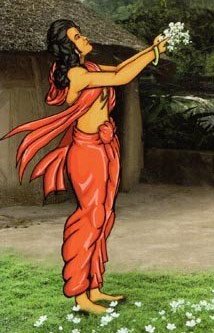Nanaka, Nāṇaka, Nānaka: 14 definitions
Introduction:
Nanaka means something in Hinduism, Sanskrit, the history of ancient India, Marathi, biology. If you want to know the exact meaning, history, etymology or English translation of this term then check out the descriptions on this page. Add your comment or reference to a book if you want to contribute to this summary article.
In Hinduism
Kavya (poetry)
Source: OpenEdition books: Vividhatīrthakalpaḥ (Kāvya)Nāṇaka (नाणक) in Sanskrit refers to the name of a coin, as is mentioned in the Vividhatīrthakalpa by Jinaprabhasūri (13th century A.D.): an ancient text devoted to various Jaina holy places (tīrthas).—(CDIAL 7050; ST p. 22, 71, 152; Sircar 1966 p. 211).

Kavya (काव्य, kavya) refers to Sanskrit poetry, a popular ancient Indian tradition of literature. There have been many Sanskrit poets over the ages, hailing from ancient India and beyond. This topic includes mahakavya, or ‘epic poetry’ and natya, or ‘dramatic poetry’.
India history and geography
Source: Cologne Digital Sanskrit Dictionaries: Indian Epigraphical GlossaryNāṇaka.—see nāṇai. Note: nāṇaka is defined in the “Indian epigraphical glossary” as it can be found on ancient inscriptions commonly written in Sanskrit, Prakrit or Dravidian languages.
--- OR ---
Nāṇaka.—a coin; see nāṇai, nānā. Note: nāṇaka is defined in the “Indian epigraphical glossary” as it can be found on ancient inscriptions commonly written in Sanskrit, Prakrit or Dravidian languages.

The history of India traces the identification of countries, villages, towns and other regions of India, as well as mythology, zoology, royal dynasties, rulers, tribes, local festivities and traditions and regional languages. Ancient India enjoyed religious freedom and encourages the path of Dharma, a concept common to Buddhism, Hinduism, and Jainism.
Biology (plants and animals)
Source: Google Books: CRC World Dictionary (Regional names)1) Nanaka in India is the name of a plant defined with Falconeria insignis in various botanical sources. This page contains potential references in Ayurveda, modern medicine, and other folk traditions or local practices It has the synonym Sapium insigne (Royle) Trimen (among others).
2) Nanaka in Sierra Leone is also identified with Streptogyna crinita It has the synonym Streptogyna gerontogaea Hook.f..
Example references for further research on medicinal uses or toxicity (see latin names for full list):
· A Hand-book to the Flora of Ceylon (1900)
· Étude générale du groupe des Euphorbiacées (1858)
· Forest Flora of British Burma (1877)
· Flora of the British India (1888)
· Enumeratio Plantarum Zeylaniae (1864)
· Illustrations of the Botany of the Himalayan Mountains (1839)
If you are looking for specific details regarding Nanaka, for example side effects, chemical composition, pregnancy safety, extract dosage, health benefits, diet and recipes, have a look at these references.

This sections includes definitions from the five kingdoms of living things: Animals, Plants, Fungi, Protists and Monera. It will include both the official binomial nomenclature (scientific names usually in Latin) as well as regional spellings and variants.
Languages of India and abroad
Marathi-English dictionary
Source: DDSA: The Molesworth Marathi and English Dictionarynāṇaka (नाणक).—n S pop. nāṇēṃ n A coin.
Source: DDSA: The Aryabhusan school dictionary, Marathi-Englishnāṇaka (नाणक).—n nāṇēṃ n A coin.
Marathi is an Indo-European language having over 70 million native speakers people in (predominantly) Maharashtra India. Marathi, like many other Indo-Aryan languages, evolved from early forms of Prakrit, which itself is a subset of Sanskrit, one of the most ancient languages of the world.
Sanskrit dictionary
Source: DDSA: The practical Sanskrit-English dictionaryNāṇaka (नाणक).—A coin, anything stamped with an impression; एषा नाणकमोषिका मकशिका (eṣā nāṇakamoṣikā makaśikā) Mṛcchakaṭika 1.23; Y.2.24.
Derivable forms: nāṇakam (नाणकम्).
Source: Cologne Digital Sanskrit Dictionaries: Shabda-Sagara Sanskrit-English DictionaryNāṇaka (नाणक).—n.
(-kaṃ) A coin, or any thing struck or stamped with an impression.
Source: Cologne Digital Sanskrit Dictionaries: Benfey Sanskrit-English DictionaryNāṇaka (नाणक).—n. A coin, [Yājñavalkya, (ed. Stenzler.)] 2, 240.
Source: Cologne Digital Sanskrit Dictionaries: Cappeller Sanskrit-English DictionaryNāṇaka (नाणक).—[neuter] a coin.
Source: Cologne Digital Sanskrit Dictionaries: Monier-Williams Sanskrit-English DictionaryNāṇaka (नाणक):—n. a coin or anything stamped with an impression, [Yājñavalkya; Mṛcchakaṭikā; Hemādri’s Caturvarga-cintāmaṇi]
Source: Cologne Digital Sanskrit Dictionaries: Yates Sanskrit-English DictionaryNāṇaka (नाणक):—(kaṃ) 1. n. A stamped coin.
[Sanskrit to German]
Sanskrit, also spelled संस्कृतम् (saṃskṛtam), is an ancient language of India commonly seen as the grandmother of the Indo-European language family (even English!). Closely allied with Prakrit and Pali, Sanskrit is more exhaustive in both grammar and terms and has the most extensive collection of literature in the world, greatly surpassing its sister-languages Greek and Latin.
Kannada-English dictionary
Source: Alar: Kannada-English corpusNāṇaka (ನಾಣಕ):—
1) [noun] a mark, symbol, etc. that is stamped on (something).
2) [noun] a usu. round piece of metal with a distinctive stamp, and of a fixed value and weight, issued by a government as money; a coin.
Kannada is a Dravidian language (as opposed to the Indo-European language family) mainly spoken in the southwestern region of India.
See also (Relevant definitions)
Starts with: Nanaka mara, Nanakacandrodaya, Nanakam, Nanakama, Nanakamam, Nanakanda, Nanakantikan, Nanakapanthi, Nanakapariksha, Nanakaparikshaka, Nanakaparikshin, Nanakapatha, Nanakara, Nanakaram, Nanakarana, Nanakarman, Nanakarya, Nanakatani, Nanakkantam.
Ends with: Ajananaka, Ananaka, Annanaka, Asvapnanaka, Avinnanaka, Denanaka, Gathajananaka, Ghananaka, Jananaka, Kananaka, Nirnanaka, Patihananaka, Purnanaka, Savijnanaka, Savinnanaka, Vijnanaka, Vinnanaka.
Full-text: Nanakaparikshin, Nanakapariksha, Nanakam, Parikshin, Nirnanaka, Nana, Nanaka mara, Nanakacandrodaya, Nanak, Navananayam, Gurucandrodayakaumudi, Nanai, Manaka, Nanayam.
Relevant text
Search found 4 books and stories containing Nanaka, Nāṇaka, Nānaka; (plurals include: Nanakas, Nāṇakas, Nānakas). You can also click to the full overview containing English textual excerpts. Below are direct links for the most relevant articles:
Yajnavalkya-smriti (Vyavaharadhyaya)—Critical study (by Kalita Nabanita)
Chapter 1.2b - Date of the Yājñavalkyasmṛti < [Chapter 1 - Introduction]
Prasthanatrayi Swaminarayan Bhashyam (Study) (by Sadhu Gyanananddas)
4.1. Life and Work of Bhagavān Svāminārāyaṇa < [Chapter 1 - Introduction]
Complete works of Swami Abhedananda (by Swami Prajnanananda)
Chapter 2 - The Religion of India Today < [Discourse 1 - India and Her People]
Shukra Niti by Shukracharya (by Benoy Kumar Sarkar)